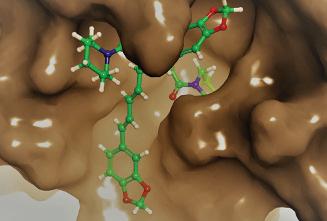
7 minute read
Mexican Researchers Discover that Black Pepper May Have AntiViral Effects Against Covid-19
An interview with Dr. Juan Vázquez Martínez, head of a group of Mexican researchers who have discovered the anti-viral effects of black pepper in combatting Covid-19(1).
The Severe Acute Respiratory Syndrome Coronavirus 2 (SARS-CoV-2) has positioned itself as the disease of the twenty-first century. By 13 October 2020, there were almost 38 million cases of infection around the world and more than a million deaths caused by it.2
Advertisement
Dr. Juan Vázquez Martínez, thanks to you and your team of Mexican scientists involved in the discovery, the somber outlook on the pandemic caused by the coronavirus begins to show glimmers of light. Could you explain the findings of your research to us?
We found that a group of compounds known as piperamides and alkamides have great potential for interfering with some of the key enzymes involved in the virus’s infection process: both the human enzyme ACE2 and the viral enzymes Mpro and RdRp. These compounds are found in plants, particularly those of the Piperaceae and Heliantheae families, representative members of which are black pepper and chilcuague (known as Azteca gold root), respectively. The best results were found among the dimeric piperamides, where pipercyclobutanamide B forms a complex with the viral Mpro. In the simulations we ran, this pipercyclobutanamide B-Mpro complex proved highly stable, making it the main candidate to be used as an antiviral against the virus.
What exactly are the properties of the piperamides and alkamides, and what are their potential effects against the SARSCoV-2 virus?
In chemical terms, these compounds belong to the group of amides, or more generally to that of natural nitrogenous metabolites, which are bioactive in many systems and organisms. In previous research, we have described the bioactivity of both alkamides and piperamides in bacteria, fungi, plants, and insects. There is also some evidence of their activity in viruses. We therefore undertook to explore their potential effects against SARS-CoV-2.
What is the pharmacological potential of these inhibitors?
These compounds, especially pipercyclobutanamide B, have the potential to bind in a stable manner with the main protease of the virus (Mpro) and therefore to interfere with its activity. Mpro is one of the main non-structural proteins that enable the virus to complete its cycle within the cells. The function of Mpro is to cut the polyproteins, thereby producing the proteins necessary to the replication of the virus. Moreover, an absorption, distribu tion, metabolism, and excretion (ADME) profile and Lipinski’s rule of five showed that these compounds have a potential as drugs for oral absorption by humans.
What were the processes and techniques used to undertake the studies?
This part of the project consisted of computer simulations to determine the inhibitory potential of around 100 alkamide- and piperamide-type compounds against three enzymes related to the infectious process of the virus. The testing by our silicon friends included techniques of molecular docking, molecular dynamics, ADME profiling, Lipinski’s rule of five, and Jorgensen’s rule of three. Taken together, these molecular modeling techniques allowed us to make the predictions described for these compounds: the potential for inhibiting the replication of the virus and for being administered orally in humans.
What information or event motivated the research?
The project was a response to the economic and social impact of the Covid-19 pandemic on different population groups. Following an exhaustive analysis of the information available at the beginning of 2020 about the antivirals proposed and approved to combat the virus, we reached the conclusion that many of these antivirals belong to the group of nitrogenous metabolites. They contain amide groups, cyclical and aromatic. Based on these observations, and our prior knowledge of the characteristics and properties of alkamides and piperamides, we considered the possibility of their use against the virus. We then put together a team of experts in toxicology, biochemistry, chemistry, chemical analysis, organic synthesis, natural products, and molecular modeling, whose joint contributions led to the results we have presented.
Mpro vs piperciclobutanamide B cardboard representation

Can you suggest any follow-ups for ongoing research or future experiments?
In our particular case, the path to follow is to continue with the synthesis or purification of the compounds identified in order to perform in vitro trials on inhibitory effects against the Mpro protease of SARS-CoV-2. We are seeking financing for this phase. In more general terms, ongoing research should focus on safe, efficient, and accessible vaccines, treatments, and medical protocols. Not only for this new virus, but also in order to prevent the appearance of more aggressive strains.
Is it possible to know what concentration or quantity of black pepper is required for its components to have the desired effect?
Yes, but there is still a lot to do. First of all it is necessary to determine the inhibitory effect of the pure extracts and/or compounds of the Mpro protease in vitro. Then to develop research protocols for trials on laboratory animals and/or humans. Once we know this, given that black pepper contains 1.2 mg per kilo of the more active compounds and around 50 mg per kilo of the less active ones, the calculation can be done. But we can already predict that it might be too much, so the ideal thing would be to purify or synthesize the compounds.
Mpro vs piperciclobutanamide B surface representation

Judging from your own experience, what is the greatest challenge at present for scientists and researchers in their combat against Covid-19?
I believe the greatest challenge is to achieve a socially engaged science, which is to say: for science to be fully disseminated in and understood by society. For society in general to realize that we are all on the same team! Most of us who dedicate ourselves to research are trying to contribute to the economic and technological development of the country. We require greater investment in education, science, and technology, shared among all the educational institutions that perform research. We also need scientists to develop the capacity to transmit information so that it can be readily understood, moving away for a moment from technical language and using more colloquial language. This has to be done in a harmonious way, balancing the demands of researchers and needs of the public, with the government as the invisible interlocutor, whose main function is to encourage both first-rate research and the public dissemination of scientific knowledge. In order to foster research sustainably in Mexico, we need accumulated investment programs with the guarantee that every centavo invested will positively impact some sector of society or some high-priority issue in the short, medium, and long terms. Owing to the importance of their research, the American Chemical Society made the original article by Dr. Juan Vázquez Martínez and his group of Mexican researchers, published in The Journal of Physical Chemistry Letters, available online (posted 25 August 2020): <https://pubs.acs.org/doi/10.1021/acs. jpclett.0c01685>
(1) Juan Vázquez Martínez, the head of the research described in this interview, is a regular member of the American Chemical Society, holds Professional Development status in Mexico( PRODEP profile), and belongs to the Sistema Nacional de Investigadores of the CONACyT (level 1) and to the faculty of the Instituto Tecnológico Superior de Irapuato (ITESI-CA-8). He is also a researcher of the biochemical engineering education program of the Tecnológico Nacional de México (TecNM), ITESI campus. Dr. Martínez holds an undergraduate degree in biochemical engineering, with a focus on environmental engineering, from the Instituto Tecnológico de Morelia and a master’s degree and doctorate in plant biotechnology from the Centro de Investigación y de Estudios Avanzados of the Instituto Politécnico Nacional (CINVESTAV-IPN). He has also done postdoctoral work at the Natural Products Chemistry Laboratory of the CINVESTAV-IPN Irapuato and has been on the faculty of the TecNM/ITESI for two years, during which time he has worked on research projects dealing with the bioactivity of compounds of natural and synthetic origin, particularly esters and amides of unsaturated fatty acids. Others who took part in the research are Juan Manuel Gutiérrez Villagomez, Tonatiu Campos García, Jorge Molina Torres, and Mercedes G. López, in collaboration with the Institut National de la Recherche Scientifique (Canada) and CINVESTAV-IPN Irapuato. 2“El mapa mundial del coronavirus: más de 37,9 millones de casos y más de un millón de muertos en todo el mundo” (13 October 2020), available online at RTVE.es: <https://www.rtve.es/noticias/20201013/ mapa-mundial-del-coronavirus/1998143.shtml>










